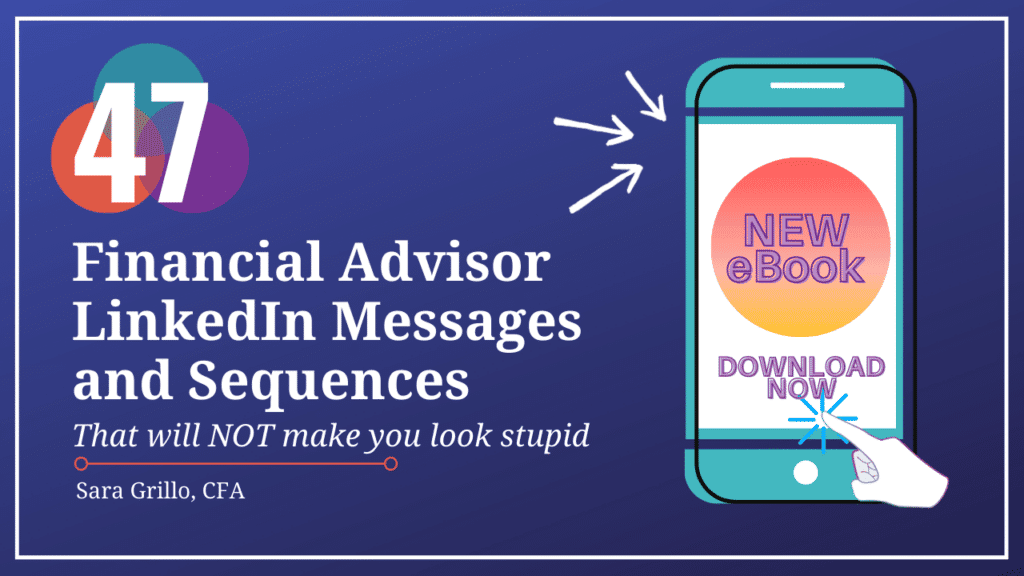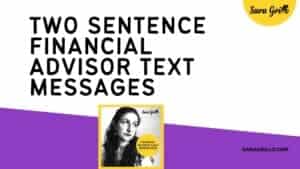Podcast: Play in new window | Download
This blog is about what financial advisors should say on LinkedIn. Use these five phrases.
For those of you who are new to my blog/podcast, my name is Sara. I am a CFA® charterholder and I used to be a financial advisor. I have a weekly newsletter in which I talk about financial advisor lead generation topics which is best described as “fun and irreverent.” So please subscribe!
Let’s get on with the blog!
How financial advisors should start conversations on LinkedIn
Before I get into what the five phrases are, let’s talk about your overall approach and the principles that should guide you. This is going to guide you into the knowledge of what financial advisors should say on LinkedIn.
Most financial advisors built their businesses from word of mouth or referrals. The idea of talking to somebody who doesn’t know them, and having to win the trust, is very foreign. The analogy I would make is that it’s like a wall with a secret phrase written underneath 15 coats of paint. With each question you ask or statement you make, you either add a coat of varnish, or take away one of the existing coats of paint.
Your goal with every statement you make is to take off a layer of paint.
I think a lot of you financial advisors operate under the assumption that people are just going to open up their lives and tell you about their pending divorce or that they’re about the inherit $2MM. You can’t always judge a book by its cover.
I hear financial advisors all the time saying ridiculous things like there are no qualified clients on LinkedIn, or that the prospect was being a jerk in the meeting and just wanted free information. If you are constantly encountering this situation, it’s your fault. There is something about how you are communicating that is preventing the qualified people from wanting to engage with you, and/or when you get into a conversation with a buyer you aren’t saying the right things.
Let’s start with the surface, the way we perceive each other prior to any engagement. You’ve got to read people like a book.
My painful anecdote about how assumptions about other people are often wrong
Once when I was a financial advisor, I become involved with a group of people through volunteering. One of the people said to me, “You know Sara, I’d like to sit down and talk with you about my portfolio sometime.”
Well, I didn’t think that John (not his real name) had any dough, so in the first meeting, right smack in the beginning, I let him know that my portfolio minimum was $1MM. And boy did I feel embarrassed when he responded with, “Oh Sara, don’t worry about that. I’ve got well over $2MM.” Little did I know, years ago he was a luxury goods salesman.
That was soooo presumptuous and even years later it hurts to reminisce.
What I learned, though, is that the way someone acts, dresses and behaves during hang out time isn’t necessarily correlated with how much money they have. That is why I suggest that you treat everyone on LinkedIn as if they are a possible buyer/referral source. Most won’t be, but many will surprise you. That is why you should treat them as if they are and see where it goes. You never know the value someone may impart to your business and it’s not always plastered in bright letters to their LinkedIn page for everyone to see.
There is a part of ourselves that we hold back and for some people it’s not a risk to put some of it out there, for others it’s hidden under 15 coats of paint.
There are no shortcuts to removing the coats of paint
If I want to get clients by sending LinkedIn messages, should I just get Sales Navigator and go hit a bunch of people up, daily?
Alright, I’m about to get psycho.
There is no clearer way to say this:
HECK NO. RUN IN THE OTHER DIRECTION FROM LINKEDIN SALES NAVIGATOR.
It will make you look like spamming LinkedIn sales schmuck.
What about LinkedIn premium? Should I get that?
Heck no. Nobody reads InMails.
What about LinkedIn paid ads? Should I use those?
Heck no. Even my five year old thinks ads are annoying.
Take these actions TODAY:
- Stop paying for things people hate on LinkedIn.
- Instead go find some people who will love you.
- Love your posts.
- Love your mission.
- Love talking to you on a daily basis.
- Love whatever you will give them.
There’s a gazillion people on the platform. If you’re getting crickets you haven’t tried hard enough to find them.
Or you did find them and you messed it up, probably by foisting one of the “poison pills” on them (see above). Either way, you have some work to do.
There is no step by step playbook for what financial advisors should say on LinkedIn that will work 100% of the time, and no shortcuts. I know you have a quota and bills to pay. But going about LinkedIn according to your schedule is going to get you ignored. You have to let the client lead you through the conversation. You have to give up control in a sense, let them drive, and you redirect the conversation when it’s the right time.
You have to listen for these opportunities to redirect. This takes skill and practice. Try it at home. If you have kids, try it with them. Instead of asking them leading, presumptuous questions, just ask totally open ended questions and see where they go. Don’t talk over them. Just wait until you hear them say something that can connect to the information you want them to give you, and gently move the conversation towards that topic.
Do you know how much children get talked over? This is a real issue. Children’s feelings are constantly invalidated, and then when they grow up they do the same thing. We are a society of boundary invaders.
Talking over people gets you ghosted
Silence is the most powerful word in any conversation between two people because it allows them to breathe. Fail at this, and you’ll be ghosted, written off, and have an empty pipeline. On the other hand, it is extremely rare when someone can actually do this, so once you learn this skill you’ll be noticeably different from the other financial advisors who talk over everyone.
If you want to succeed with other people it’s not about being funnier, smarter, or cooler – it’s about being more understanding of them. Let’s talk about the language of understanding.
What financial advisors should say on LinkedIn – 5 phrases
Now for the feature presentation. Here’s what financial advisors should say on LinkedIn if they want to get people interested in working together.
#1
“Tell me more.” (and then SHUT UP and let them talk)
Someone is talking about something in their life – let them talk. They know you’re a financial advisor as long as you’ve clearly outlined this on your LinkedIn page.
Let people talk about what is important in their lives, and eventually they will somehow mention something related to finance. You’ll eventually get a clue or a signal that will allow you to transition in.
See this blog about transition strategies on LinkedIn for the full explanation of how to do this. This is not that easy to do. It takes skill and practice.
But once you gain the ability to do this, you’ll see that when people talk and you really listen, they tell you what you need to know to understand them.
#2
“I’m listening.” (and then SILENCE to show them you’re listening)
It really surprises people to hear this.
#3 “Could you please elaborate more on what you just said?”
Let’s say that they are getting into an area where you could redirect it to something pertinent to their finances. For example, someone says, “My wife and I have been working hard on our business, with the COVID we had to let a bunch of people go.”
You transition in with: “Could you please elaborate more on what you just said? I hear this from a lot of business owners but in every case the financial repercussions are different.”
See? I didn’t turn them off by jumping into the suggestion for a meeting.
#4 “I need to understand you (what you said, your last statement, etc.) better.”
This is beautiful to hear. Do you know how hard it is for someone to feel that you are not listening when you say things like this?
The more you can play back someone’s words, the more they feel listened to. This statement immediately removes some of those coats of paint.
#5 “Before I respond, let me take a pause and ask you some questions about what you just said.”
Conversations get derailed when people ask you a direct question. I really don’t want financial advisors giving away a ton of free person-specific information in your meetings with prospects.
Read this blog about financial advisor prospecting meetings and how much you should give away for free in the first meeting.
This drives me NUTS.
It takes away your own value, and also it’s not completely fair to the prospect. If you haven’t done the proper diligence that you would do for a client, how can the advice really be true? If you have the flexibility to do hourly or flat fee pricing, you should tell the client that you can’t answer the question without entering into a formal engagement.
“This is a very serious question and I can’t answer this from just our conversation alone. It may be better to sit down and work on this in a session, that way I can truly attend to all the details that are being mentioned here.”
When someone asks you a direct question that you can answer in a credibility building way, you’re engine gets revving. I know. You think if you answer it intelligently it will impress them into wanting to hire you. And some of the time you may be right, but it depends on the intentions of the person you are talking to. Some people use financial advisors for free information. Or, they may very well intend to hire you, but if you are going to give them the information when they ask for it, what basis do they have for shelling out the $4,000?
A business owner says, “My wife and I were thinking about setting up a retirement account for our business but we can’t decide between 401k and defined benefit plans.”
STOP don’t answer that! Don’t do it financial advisors! I want you to hear Sara G’s voice in your head holding you back.
Send them a question back. It should be a stultifying question that makes them think.
“What is your capacity for IRS non discrimination testing. How would you be prepared to handle that?”
Or
“Do you view this as being more intended for the owners and shareholders or is this to benefit all employees equally?”
You kinda wanna get them to squirm a little bit. When they go to answer that, they are going to stumble and that’s when you go in with the transition and get the meeting. They’re feeling they’re on shaky ground and that is the time to ask for the meeting.
“From what I’m hearing, the answer is not clear to me. I think we should sit down and have a conversation about it.”
You didn’t ask them for the meeting before they were ready. You have developed demand here. They’ll know they’re in over their head and they’ll probably agree to the meeting or even ask for it.
When you take the time to listen to and observe other people, you will find that they more or less will tell you what it is that you need to know about them.
Sara’s upshot
What’d ya think? Was this helpful?
If yes…
Learn what to say to prospects on social media messenger apps without sounding like a washing machine salesperson. This e-book contains 47 financial advisor LinkedIn messages, sequences, and scripts, and they are all two sentences or less.

You could also consider my financial advisor social media membership which teaches financial advisors how to get new clients and leads from LinkedIn.

Thanks for reading. I hope you’ll at least join my weekly newsletter about financial advisor lead generation.
See you in the next one!
-Sara G
Music is Nice to You by the Vibe Tracks





